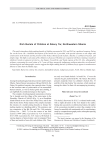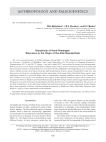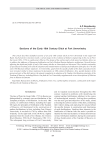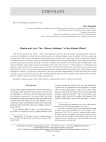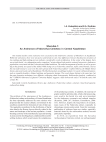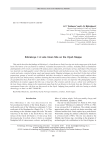Статьи журнала - Archaeology, Ethnology & Anthropology of Eurasia
Все статьи: 351

Remains of brown bear (Ursus arctos L.) from the Kaninskaya cave sanctuary in the Northern Urals
Статья
Бесплатно

Remnants of the snake cult among the Khakas (late 19th to mid 20th century)
Статья обзорная
Бесплатно

Статья
An especially noteworthy part of the Firsovo archaeological area is a group of early burials at the fl at-grave cemeteries Novoaltaisk-Razvilka, Firsovo XI, and Firsovo XIV. Nine radiocarbon dates have been generated for those cemeteries at various laboratories: two by the liquid-scintillation (LSC) method and seven using the accelerator mass spectrometry (AMS) method. The dates were calibrated using OxCal version 3.10 software. Dates for the Chalcolithic Bolshoy Mys culture burials at Novoaltaisk-Razvilka and Tuzovskiye Bugry-1 burial 7 match the previously suggested ones (around 3000 BC). Certain Neolithic burials in the Altai differ from others in the position of the bodies (fl exed on the side). They were dated to the late 5th to the early 4th millennia BC by the AMS method. Burials belonging to the “cultural core” of Firsovo XI, then, fall within the Early Neolithic (68 % interval, 5710–5460 BC; 95 % interval, 5740–5360 BC). The date 9106 ± 80 BP (GV-02889), obtained for Firsovo XI burial 18, may be somewhat accurate, pointing to the Final Mesolithic or Early Neolithic. Both the date and the cultural characteristics of this burial (sitting position, abundant ocher) are accompanied by the craniometric distinctness of the male cranium (huge total size).
Бесплатно

Статья
We describe a group of Egyptian faience scarabs unearthed from the necropolis on the Iluraton Plateau, Eastern Crimea, by the expedition from the State Museum of the History of Religion (St. Petersburg) in 1987–1990. Artifacts made of so-called Egyptian faience were found in eight of the sixty-two burials—those of g irls aged below 1.5, dating to the 1st to early 2nd centuries AD. The most numerous among the faience items were beads in the form of scarabs. The analysis shows them to fall into three groups in terms of presence and nature of images on the reverse side: those without images (3 spec.), those with abstract images (3 spec.), and those with anthropo-zoomorphic images (2 spec.). In two cases, representations point to specifi c Egyptian workshops. Scarabs in girls’ burials of the Roman period elaborate on the thanatological imagery, which originated among the Scythian-Saka tribes of Eurasia in the mid-1st millennium BC.
Бесплатно
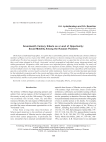
Seventeenth century Siberia as a land of opportunity: social mobility among the Russian pioneers
Статья обзорная
Бесплатно
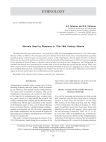
Shovels used by Russians in 17th-18th century Siberia
Статья
The study describes types of the shovel—one of the most widely used and multifunctional tools in 17th–18th century Russian culture of Siberia. The principal collection includes more than twenty intact and fragmented specimens unearthed during 13 fi eld seasons of excavations at Tara, in the Omsk Region. Shovels found elsewhere in Western Siberia are also described, and the role of this tool in the households of Russian pioneers in Siberia is assessed. Judging by the drawings in Semen Remezov’s chronicle and excavation records from Tara, Mangazeya, and Nadym forts, we conclude that shovels were specialized for various kinds of work, and that they varied with the season. There were diverse types used for constructing fortifi cations, dwellings and utility structures, for digging graves, tillage, clearing snow, handling bulk materials, and baking bread; children’s toy shovels are also described. Information is provided on shapes of shovels and the types of wood Siberians used for making them.
Бесплатно
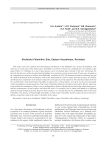
Shulbinka Paleolithic site, Eastern Kazakhstan, revisited
Статья
This study revises the cultural and chronological attribution of the Shulbinka site, Eastern Kazakhstan, with reference to recent ideas of the Early Upper Paleolithic in northern Central Asia, including new sites dating to that stage (Tolbor-21, Ushbulak, etc.) and a representative series of absolute dates relevant to the site’s chronology. We describe the discovery of the site and principal fi ndings of excavations carried out more than 20 years ago, focusing on the comprehensive analysis of artifacts from Shulbinka, conducted in 2019. We demonstrate that the estimated age and the cultural attribution of the site disagree with earlier interpretations. Earlier claims about the presence of Levallois and Mousterian components in the primary reduction system appear poorly supported. The idea that artifacts from the site resemble those of the Early Upper Paleolithic is subjected to a critical inquiry. As it turns out, the closest parallels to this assemblage are found among the Final Upper Paleolithic industries of southern and central Siberia. Important traits include the combination of large cores for making fl akes, blades with edge-faceted and wedge-shaped microcores, and the predominance of end-scrapers and chisel-like tools. Few parallels can be found with industries of different cultural and chronological periods. Based on these analyses, we conclude that the site of Shulbinka dates to the Final Paleolithic. The absence of Final Middle Paleolithic or Early Upper Paleolithic markers makes the site irrelevant to debates around the origin of the Upper Paleolithic in the region.
Бесплатно

Stages in the late Pleistocene and Holocene peopling of lake Bolshoye Ushkovskoye shore, Kamchatka
Статья обзорная
Бесплатно

Substitute offering: an Ob Ugrian ritual tradition surviving in the 20th and early 21st century
Статья обзорная
Бесплатно


